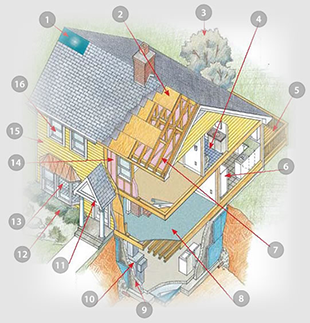| How Homes Go Green |
 |
More durable roof coverings such as steel and fiber cement reduce the frequency of roof replacement. Lighter colors absorb less heat, reducing cooling costs in warm climates. Now, solar roofing products integrate asphalt shingles, standing-seam metal roofing, and slate or concrete tiles.
Energy-efficient windows incorporating advanced technologies like low-emittance (low-E) glass coatings, gas filler between layers, and composite framing materials keep heat inside in the winter and outside in the summer.Oriented strand board (OSB) is an engineered wood product that does not require large trees for its manufacture. It is resource efficient and enhances durability and is used to sheathe roofs and walls in 75 percent of new homes.
Vinyl siding on exterior walls saves money on installation and maintenance; fibercement siding is termite- and water-resistant and warrantied to last 50 years.
Increasing the amount and R-value of insulation is a cost-effective way to save energy and help reduce heating and cooling bills, which account for at least half of energy use in the home. Sprayed insulation made of foam, cellulose or wool is an alternative to traditional glass fiber batting.
Incorporating passive solar design features like large, south-facing windows helps heat the home in the winter and allows for increased natural daylighting.
Xeriscaping, or using native plants, significantly reduces the need for watering, fertilizers and herbicides.
Covered entries at exterior doors help to prevent water intrusion, reducing maintenance and enhancing durability.
Selecting more efficient, correctly sized heating, cooling and water-heating equipment saves money. Tankless water heaters provide hot water on demand at a preset temperature rather than storing it, which reduces or eliminates standby losses. Geothermal heat pumps work with the Earth’s renewable energy and can also heat water.
Foundations should be as well insulated as the living space walls for efficient home energy use and enhanced comfort, particularly if the basement is used as a family room or bedroom.
In addition to natural wood, flooring choices include low-VOC (volatile organic compounds) carpets for better indoor air quality, laminates that successfully mimic scarce hardwood, and linoleum, a natural product making a design comeback.
Factory-built components including trusses and prehung doors allow more efficient use of raw materials, making the most out of every piece of lumber. These products eliminate the need to cut wood at the jobsite, further reducing waste.
The energy efficiency of refrigerators and freezers has tripled over the last three decades because they have more insulation, advanced compressors, better door seals and more accurate temperature controls. Front-loading washers use about 40% less water and half the energy of conventional models. Energy Star®-rated appliances save an average of 30 percent over standard models.
Recycled plastic lumber and wood composite materials reduce reliance on chemically treated lumber and durable hardwood for decks, porches, trim and fencing.
New toilets have redesigned bowls and tanks that use less water, but function more efficiently than first generation low-flow models. Some use pumps for supplementary water pressure. Advanced shower and sink faucet aerators provide the same flow regardless of pressure to reduce water use and the energy required to heat it.
Tree preservation reduces landscaping and future energy costs and helps provide winter wind breaks or summer shade. Additional landscaping improves the environment even more: One tree can filter 60 lbs. of pollutants from the air each year.

